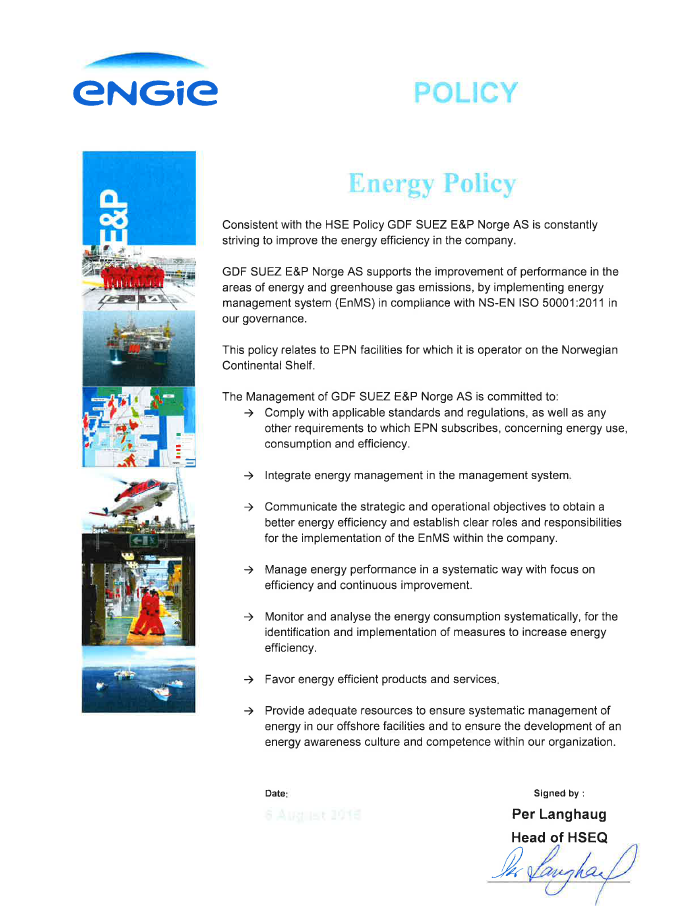A good start makes the way forward easier. For energy management this consists of engaging the relevant people, establishing an energy team, defining the energy policy and the main principles.
You must decide yourself if you wish to certify the energy management system or rather just follow the main principles and requirements from the standard.
ISO 50001 was published in 2011 and is one of the most important standards for energy management. The standard provides requirements for establishing, implementing, maintaining and improving energy management systems. The purpose of the system is to enable organisations to achieve continuous improvement of their energy performance, including energy efficiency, energy use and energy consumption, in a systematic way.
![]() What should be done?
What should be done?
Three main points should be covered during this phase of planning:
- Engage the management and organisation
- Establish an energy team with a clear mandate
- Define the energy policy and the main principles for energy management
Engaging the management and organisation should be done by raising awareness among the management, for example through setting energy management on the agenda as one of the topics to be covered during important meetings. Here management must be able to inspire the rest of the organisation through positive measures.
The management must make sure that an energy team is established and that this team obtains a mandate from them.
| Example of a clear mandate for the energy team |
|---|
|
The management, in cooperation with employee representatives, must define the strategy for energy management. They should define the main principles for energy management for the energy team to work with.

The management should ensure that the persons working with energy are provided with the necessary knowledge through training and relevant courses. It is therefore necessary to identify the training needs through the organisation and take the necessary steps to ensure that the organisation as a whole is aware of how they can work with energy management and efficiency.
Several opportunities for organising the daily work were identified during the industry project:
- It is important to build upon what already exists (for example within optimisation and other processes that exist).
- It is best to establish energy targets that employees can influence, therefore the operations organisation must be involved in establishing their own targets.
- It is essential to work daily with energy management. This should become a part of the company culture.
![]() Who should be involved?
Who should be involved?
Best practice revealed during the industry project shows that an energy team is usually established in the organisation to setup the management’s energy policy. Usually the energy team consists of persons from various disciplines, and the energy leader has an important role in the team. In addition, a management representative should be included in the energy team, although this person does not need to attend all meetings.
| Definition of the energy leader and the representative from management |
|---|
|
Below is an example of members in the energy team:
- Management representative
- Energy leader
- Engineering:
- Process
- Rotating machinery
- Electrical
- Automation
- Operations support onshore
- Operations personnel
- Offshore Installation Manager (OIM)
- Line managers
- Procurement
The senior management should be present at the first meeting, to show that energy management is a focus area for the organisation.

| Advice for the energy team |
|---|
|
![]() What should be documented?
What should be documented?
An energy policy shall be defined as part of the energy management system, and it should be implemented and integrated in the existing management system. Some companies have good experience with this and it leads to awareness in the organisation.
The system boundaries for the energy management system (i.e. scope) should be documented, with where, who, etc.
The mandate for the energy team should be documented from the management side.
![]() Challenges and opportunities
Challenges and opportunities
Experience from the industry shows that several challenges exist and opportunities related to what may occur during the start-up phase. Some of these are presented below and are based on responses from a group exercise at a seminar during the industry project.
My manager is not committed enough
- Strategy: It should be included in the strategy that energy management is a high priority for the company. This shows to society at large and other stakeholders that the organisation take greenhouse gas emissions seriously, and invests time and resources in working with energy efficiency.
- Finance: Energy management must be linked to the financial aspects in the company and show that it contributes to cost savings. This can lead to higher engagement from stakeholders since this can have an impact on dividends.
- KPI: Some KPIs could be linked to bonuses (e.g. a reward in terms of a vacation, or monetary bonus when the employee achieves his goal).
- Engagement: The management must show an active involvement throughout the company if they want to engage their employees. This can be done by setting energy management high on the agenda during important gatherings between employees and top management (as is often done with safety for example).
Operational support personnel onshore are not interested in energy management
- Target: The management must provide clear and simple targets about how energy management must be implemented in the company.
- Visibility: If various improvement measures are successful it is important to communicate this to the employees by showing the actual results of the work.
- Awareness: The employees must understand why they need to work with energy management. They must be given ownership in order to want to continue working with it.
- Tools: It is important to present what has been done as a company in a good way, mainly by having good tools to communicate results.
- Technology: The use of new technology must be promoted internally in the company.
Operators working offshore do not relate to energy management and the work around it
- Visibility: It is important to show the value of the results of energy management. This must be made visible continuously through the operations organisation.
- Feedback: Use suggestions boxes, and provide feedback on the results if a suggestion has been followed-up and implemented.
- KPIs: It is important that the employees feel they can influence the KPIs. Employees should be involved when the KPIs are defined, this helps creating ownership for the KPIs they have participated in setting. This can be done through breaking down the overall KPIs down to the different levels of the organization in a meaningful way (known as a “KPI structure”).
- Impact: Important that employees know exactly how they can contribute for reaching the targets. That way, the employees at the bottom of the organisation can see that what they do contributes to the end result.
Energy management always ends-up at the bottom of my to-do list
It should be integrated in the daily work, along with other work routines (for example at morning meetings and on other occasions). Having energy management as part of the job description and specifying the percentage of the time that should be dedicated to working with energy management can also help.
No one in my organisation knows what energy management is
- Energy management should be part of the presentations and meetings that the management has with employees.
- It is important to communicate success stories, which hopefully will lead to greater awareness on energy management.
- The emission reductions and cost savings achieved by implementing improvement measures should be clearly communicated by those involved in the work, together with the management.
The relevant people are not involved in energy management
- Make it attractive to work with energy issues, for example by showcasing the good things in the organisation, a small salary increases for those who take it upon themselves to work with the energy challenge or promote people who contribute to the work on energy efficiency. It is important to make the employees feel valued.
- The management must make sure to pick the most suitable people by having due process for selecting candidates to the energy team. This can be done through a thorough mapping to identify the resources that want to work with energy management and who possess the right knowledge.
![]() Energy management in practice
Energy management in practice
| Energy Policy at ENGIE |
|---|

|
| Statoils energy coordinators on the Norwegian Continental Shelf |
|---|
|
Statoil has a dedicated energy coordinator for the whole Norwegian Continental Shelft (NCS). This person has the task of ensuring that all Statoil installations on the NCS are operated in the most energy efficient way. There is also one energy coordinator per installation, with a clear mandate to use 15% of their time working with energy management. The overall energy coordinator supports the work and collects information from each installation. |
| Introduction of energy management at Repsol (formerly Talisman) |
|---|
|
Senior management showed interest when Repsol decided to introduce energy management in the organisation. They wanted to contribute with what they could. The responsible for external environment then had a meeting with several top managers to establish their contribution. This led to a better grounding in the organization as such and made the implementation of energy management easier. |
![]() Where do you find this in ISO 50001?
Where do you find this in ISO 50001?
- Chapter 4.2 Management responsibility
- Chapter 4.3 Energy policy

